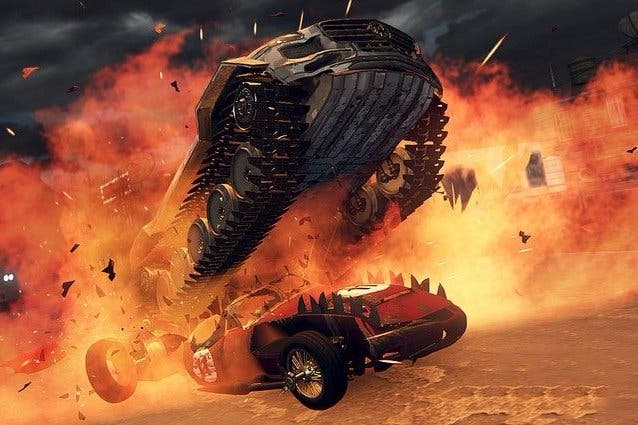Face-Off: Carmageddon: Max Damage
Crash and burn?
Developed by original creators Stainless Games, Carmageddon: Max Damage serves as both homage and sequel to the first PC titles from 1997 and 1998, combining car combat, racing, and general road rage in a package boasting a reworked physics system, an upgraded engine, and updated visuals. Produced for just £250,000 via a Kickstater funding campaign, the game originally appeared on PC in the form of Carmageddon: Reincarnation, which saw final release in February 2015 after early access and public beta phases. However, on consoles Max Damage takes the form of a further update to this game, boasting extra features and more content. It's exclusive to PS4 and Xbox One for now, but a PC release is planned for the near future.
Of course, as a budget indie production we're not looking at the same level of graphical complexity as the latest triple-A titles.. It seems that the developers have chosen to focus on the key elements essential to the gameplay, while perhaps compromising on the visual presentation in a number of areas. For example, the cityscape is pretty barren with relatively low geometry complexity, and there isn't a huge number of NPCs roaming the environment. Alpha effects for smoke and fire also look quite flat, and there's a sense that the presentation appears more in-line with an Xbox 360 title than one built for current-gen systems.
It's a little disappointing, but it's worth stressing that key aspects of the game have more extensive work put into them. Post-processing effects are rendered to a high standard, with impressive use of depth of field and deployment of object blur on the cars. But it's the physics system that is the highlight, with the way the cars handle and react to the environment having plenty of variation. Constant collisions with vehicles, pedestrians and scenery see bodywork deform and become misshapen, while in more direct impacts wheels come flying off - and it's even possible for your car to be cut in half. What's really cool here is that it's possible to repair your car while still driving, reversing the destruction in real-time. Parts fly back onto your vehicle and bodywork reforms into its original shape, all while you race.
Visually, Max Damage is closely matched across both consoles, though there a few differences which affect quality in several areas. In terms of resolution, the PS4 versions renders a native 1080p image, while on Xbox One we're looking at 900p instead. The reduction in pixel counts results in a touch more softness to the image, but on the whole this doesn't stick out obviously during gameplay and both versions provide a very similar level of image quality. The same core assets are present across both versions too, and for the most part the effects work is a match.
Xbox One owners shouldn't feel like they are missing out from the drop in resolution, and this version also benefits from faster texture streaming, where low quality assets are displayed for longer periods on PS4. It's worth pointing out that streaming issues appear to be isolated to the beginning of a race or mission, right after the environment has loaded in. But once gameplay begins both versions display the same standard of the core assets throughout. However, initial streaming is consistently slower on PS4, so this difference does appear every time we load up a new race or restart after failing.
That said, the PS4 version does make use of a higher level of anisotropic filtering, which results in road textures and markings appearing more clearly defined at long range. This is something that is visible during gameplay when surveying the road ahead, and on the whole the PS4 offers up a more refined presentation once the streaming issues have resolved.
With a low level of graphical complexity Max Damage should be pretty easy to run on console, and it wouldn't be unusual to expect a 60fps update for this arcade-style game in order to keep the controls feeling crisp while maintaining fluid motion handling. However, Stainless Games plays it safe here and opts for a more manageable 30fps target instead. Frame-rates are mostly locked at that level for extended periods, but it's surprising to find that performance isn't completely stable throughout. Gameplay is interrupted by some small dips and pockets of uneven frame-pacing which introduce judder and variances in the controls on occasions where they occur.



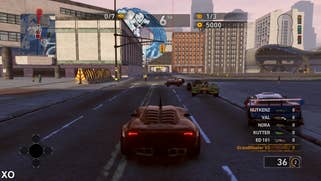
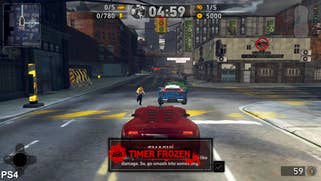
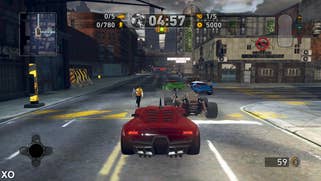
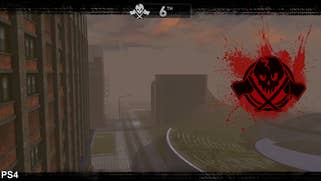



An adaptive v-sync is use to help limit the potential impact on gameplay, and it is mostly successful in keeping frame-rates at the 30fps line. However, the knock-on effect is that we see short pockets of tearing when the engine cannot sustain the target frame-rate, and this doesn't solve the issue of the uneven frame-pacing when the game hovers slightly above 30fps. This means that things don't always feel completely smooth to play, which can be a little off-putting when there is lateral movement on-screen as you take corners or quickly change direction while battling it out with other drivers.
The experience is pretty similar across both platforms, though tearing is more commonplace on Xbox One, while on PS4 we noticed a little more in the way of uneven frame-pacing on some tracks. It's not an ideal situation, but the game does look fairly smooth and feels pretty decent to play when performance is stable. We're not looking at major issues on either version, so perhaps Stainless Games could just add a little more polish and optimisation in a future patch. It's worth mentioning that the PC version performed poorly for months after release, but eventually optimisations were made, allowing the game to run smoothly without needing higher-end GPUs. Perhaps it's possible we could see a similar boost to stability on consoles.
Carmageddon: Max Damage - the Digital Foundry verdict
Overall, Carmageddon: Max Damage is a standard sequel to the late 90s PC titles, in a sense of modernising the gameplay and adding new features without straying from the blueprint of car combat and running down random NPCs across a variety of locations. It's not a game that stands out, and there's a sense that the concept in its current form does feel rather dated. However, fans are likely to enjoy the authenticity to the originals while sampling updated tracks and newer visuals - and it's clear from the success of the Kickstarter that there's still an audience for the game that will appreciate a new entry.
The console ports mostly deliver a very similar experience all round, with only a small difference in image quality and performance between them. PS4 generally appears a little more refined overall, though the slower texture streaming does stick more so than on Xbox One. Performance disappoints, though, and it's a shame that the game doesn't deliver a 60fps update, and fails to achieve a rock solid 30fps lock.
Max Damage is a pretty unremarkable-looking game and while it does have a few charms with the physics model and car destruction system, we can't help but expect a little more in terms of performance on console. Hopefully, improvements to frame-rates can be delivered via a patch, but until then, those wanting to play at 60fps should probably check out Carmageddon: Reincarnation on PC.
